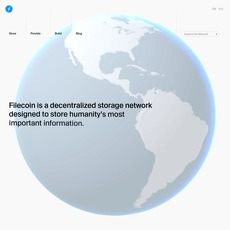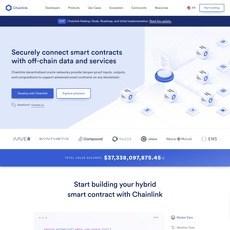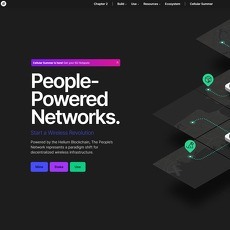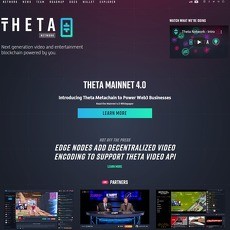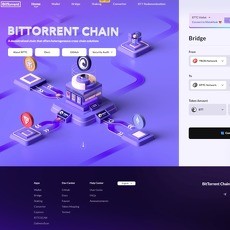Polkadot Review
Polkadot
polkadot.network
Polkadot.network: Full Website Review, Pros and Cons, and More
Polkadot has certainly taken over the cryptocurrency markets and shows no indication of wallowing out anytime soon. Polkadot, as one of the most inventive cryptocurrency projects on the market, overcomes one of the crypto enterprise's most significant challenges: a plethora of fascinating projects that are unable to engage with one another in significant and productive ways.
For many, the interaction challenge between blockchains that Polkadot has resolved makes it a standout from other networks. Are you contemplating joining the Polkadot.network and would love to know more about it? Read on as we highlight more details about the network.
About Polkadot.network
Polkadot is a cryptocurrency that aims to power the internet's decentralized future. It is compatible with other blockchains inside and outside of cryptocurrency, permits the building of smart contracts and new blockchains (and tokens), permits blockchains to interchange data, is upgradeable, and is overseen by individuals who own DOT, Polkadot's native cryptocurrency.
Polkadot attempts to overcome the blockchain trilemma by simultaneously becoming completely decentralized, fundamentally secure, and scalable for mass adoption. When compared to famous blockchain networks like Bitcoin and Ethereum, it also uses a proof of stake consensus process, which makes it significantly more energy efficient.
Who controls the Polkadot.network?
Polkadot is an open-source, permissionless blockchain. Polkadot has an innovative governance system in which all stakeholders have a say. Polkadot's advancement is future-proof and community-driven since network updates are organized on-chain and implemented autonomously without diverging the network.
Who created Polkadot?
Polkadot was created by the Web3 Foundation, a Swiss organization whose mission is to create an open-source project that allows for an entirely functional and user-friendly decentralized web. Dr. Gavin Wood, Robert Habermeier, and Peter Czaban are the company's founders.
Gavin Wood, the president of the Web3 Foundation, is the most popular of the three, given to his industry authority as a co-founder of Ethereum, the founder of Parity Technologies, and the founder of the smart contract coding language solidity.
Robert Habermeier is a Thiel Fellow and a well-known blockchain and cryptography researcher and developer.
Peter Czaban is the Technology Director for the Web3 Foundation.
Pro features of Polkadot.network
Pro features of the Polkadot.network are highlighted below to help you decide if you’ll love to join the network or not and hasten up your decisions.
● Security
In today's blockchain networks, chains are competing for security resources. Polkadot, on the other hand, pools security throughout the network, permitting individual chains to exploit pre-existing collective security rather than having to start from scratch. By pooling their security assets and commissioning them to the Polkadot relay chain, independent blockchains with varying degrees of security finalities can reinforce their particular flaws.
Even better, Polkadot's shared security strategy doesn't need a validator community to keep the system secure, permitting each blockchain's network to concentrate on scaling or runtime while deferring security to the Polkadot relay chain.
● Scalability
Most blockchain transactions are executed sequentially on network nodes, causing bottlenecks and slowing transaction speeds. Polkadot is aimed at eliminating bottlenecks by permitting many parachains to run concurrently over a single relay chain, each processing numerous transactions in parallel.
The scalability of a system with many blockchains running in parallel would be around a hundred times greater than that of a recent Proof of Stake system. Multiple relay chains could be affixed to the root relay chain in a future iteration of Polkadot, resulting in scalability 1000x to 10,000x greater than a present PoS system.
● Interoperability
Thousands of blockchains have formed in the embryonic cryptocurrency field during the last ten years. While it's unlikely that all of them will survive in a few years, the future will most probably have a plethora of different blockchains, each with its own set of capabilities.
Blockchain networks like Bitcoin and Ethereum operate independently, with no communication or interoperability. This discord must be fixed for a trustless network to flourish and succeed. Gavin Wood created Polkadot as a way to allow smart contracts on a blockchain to connect with information and assets on other blockchains.
● Smart-contract capable
Developers can utilize Polkadot to deploy decentralized apps (dApps) on its network since it supports smart contracts. With feasible projects such as the Acala network, Moonbeam, Efinity, and others, its ecosystem has become a prominent player in the decentralized finance (DeFi) ecosystem.
Secondary use case of Polkadot. network
DOT is Polkadot's native network token, and it serves a variety of functions. DOT token holders have authority over the network's direction in governance, like defining network costs, auction dynamics, and scheduling more parachains. DOT holders, like those in other blockchains, are in charge of making judgments about extraordinary events such as the Polkadot platform's network upgrades.
Polkadot's fundamental consensus process is also made easier by DOT holders. DOT holdings designate their tokens to the network to fulfill chain activities for the Polkadot network to work effectively and conduct legitimate transactions across parachains. Partakers in the network face the possibility of losing their share, which disincentivizes harmful motives. The amount of DOT needed to join the network is determined by several criteria, including the activity, the interval for which DOT is staked, and the overall number of DOT staked.
An additional benefit of DOT is that it allows additional parachains to be added by locking DOT in a process known as Bonding. After the parachain is eliminated, DOT is frozen for a long time and then released back to the initial account.
Users concerns about Polkadot
Some of the users' concerns about the Polkadot network are highlighted below.
● There are some challenges in attracting developers and projects to build on a parachain architecture
One such stumbling block is that to start an application on existing parachains; the functionality must first exist on a parachain, producing a chicken-or-the-egg situation. Another difficulty is that creating a parachain necessitates upfront funding in the form of DOT, which effectively assesses some smaller, more experimental use cases.
Polkadot is attempting to address this problem by promoting parachains that have received support from stakeholders through crowdfunding. Although Polkadot has successfully attracted developers at a competitive rate, this is still a problem unique to the Polkadot ecosystem.
● The project may be overvalued
Polkadot was able to create anticipation for a long period because of its well-known founder (Gavin Wood) and the extended time it took to launch. Nonetheless, because the project is so new and lacks real use cases and acceptance, it may be "overvalued" (in comparison to other smart contract blockchains).
Polkadot Exchanges with the Best Rates
Several well-known exchanges have begun to accept the DOT cryptocurrency on their platforms. Although the project is relatively new, the token has gotten a sufficient amount of support from some of the exchange giants. Exchanges like Binance, Crypto.com, and Kraken have recorded DOT on their channel. This is uncommon for such a new project; nonetheless, the technical team supporting the project has the authority and reputation for supporting the validity and authenticity of DOT.
Is a Polkadot Wallet required to purchase or trade DOT?
Yes. If you purchase DOT on a crypto exchange, that exchange will provide you with a built-in DOT wallet where you can keep your DOT until you choose to trade or withdraw it. Even if you can get DOT for money from a buddy, you'll still need a wallet to keep your Polkadot safe.
How does Polkadot.network work?
The Polkadot network relies on a relay chain that employs a proof-of-stake consensus method. The DOT token gives validators voting power, permitting them to partake in project judgments and development.
Also, the DOT token can be employed to connect and incentivize validators to function honestly in the network when they have a financial stake in the validation process's legitimacy.
This enables anyone betting on DOT to block the token in a contract to execute a function or more required for it to operate:
Validating roles: They are in charge of validating the data in the parachain blocks. They also participate in the network's consensus process and vote on proposed improvements in the network.
Nominating roles: They secure the relay chain by selecting credible validators and designating the DOT tokens they have staked to the validators. They cast their votes in this manner.
Collecting roles: Nodes that store a detailed record for each parachain and include data about the parachains' transactions in blocks to incorporate them into the relay chain.
Fishing roles: Fishing roles: they watch the Polkadot network and report any improper manner to the validators.
Frequently Asked Questions (FAQs)
How many chains can the Polkadot.network connect?
The Polkadot network, built to be scalable, has no predetermined limit on the number of chains that can be attached to it. According to preliminary estimates, the basic Polkadot design can handle many parachains.
Polkadot has smart contracts, right?
Yes - and no. Smart contracts are not inherent to the Polkadot Relay Chain. The lack of smart contracts on the Relay Chain is due to Polkadot's design philosophy, which states that it should only contain the bare minimum of logic required to complete its task.
Polkadot, on the other hand, will serve as a platform for other chains that do use smart contracts. Parachains can allow smart contract capabilities and take advantage of Polkadot's security and interoperability details. Existing smart contract chains can connect to Polkadot through a bridge or as a parachain. Although the Polkadot Relay Chain does not directly use smart contracts, parachains certainly will.
What’s the official stance of the Polkadot.network?
Different from other assets, the Polkadot (DOT) asset maintains reserve prerequisites to prevent the shared global ledger from becoming unduly large as a result of spam or ferocious usage.
An address must have the least amount of DOT in the shared global ledger to deliver transactions. This DOT cannot be sent to any other addresses. You must send enough DOT to meet the lowest reserve provision to fund a new address.
The verifiable deposit of one DOT is required for your Polkadot account to survive on-chain and be functional.
What is the status of my locked balance?
Every member of the Polkadot network can formulate instructions for their Polkadot address that limit them from spending for specific objectives. Exodus wallet does not yet enable DOT locking; nonetheless, if you have utilized your Exodus Polkadot private keys in another wallet that does, you may then discover that Exodus displays your locked Polkadot balance.
What keeps the Polkadot governance from collapsing?
Polkadot's governance has been proven to be effective. Instances include runtime updates that have been completed successfully on testnets and in a real economic setting on Kusama and Polkadot.
It's fair to argue that the area of on-chain blockchain governance is still in its early stages, and nobody can allege to know what the best form of on-chain governance is just yet. Polkadot, on the other hand, takes a bold step forward in pioneering well-thought-out methods for blockchain evolution.
A technique for blockchains to adapt and evolve is required. As a result, Polkadot's long-term success required an on-chain governance mechanism. Token holders are ultimately liable for deterring Polkadot's governance from failing by utilizing their economic value and conviction to influence the protocol's advancement.
Final thoughts
Polkadot has shown itself to be a trustworthy and unique cryptocurrency project, and many investors are keeping a careful eye on it. It acts as a parachain crowdfunding platform, rewarding investors for putting their faith in their beloved project.
Also, as noted earlier, Polkadot is a game-changing technology for building interoperable blockchains. It has a high level of decentralization, scalability, and security. Furthermore, its Substrate platform effectively democratizes the production of new blockchains, which profit directly from its solid structure.
Polkadot has a lot of initiatives in the works, but it will take a while for this new crypto to gain traction. The good news is that it already has financial values in trading on, making it a cryptocurrency to keep an eye on.
For more crypto project reviews & DeFi guides, visit CryptoLinks.com – your #1 blockchain resource!
Will Polkadot dominate Web3? Only time will tell, but it’s certainly a top contender.


